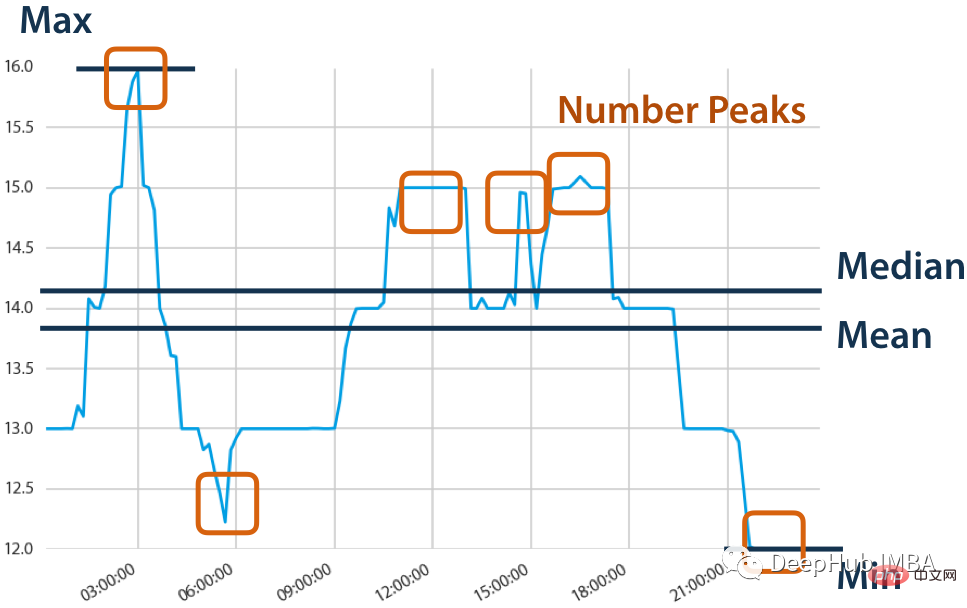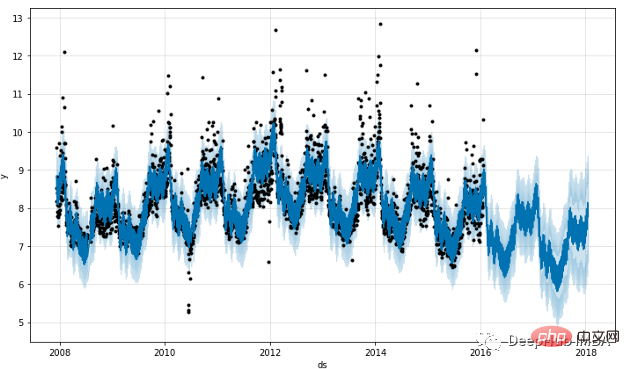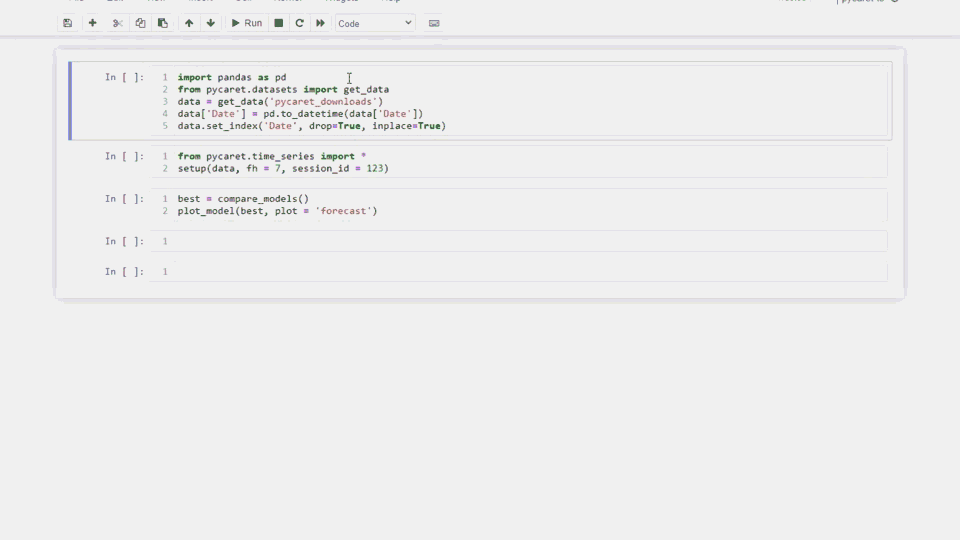 Backend Development
Backend Development
 Python Tutorial
Python Tutorial
 Ten Python libraries recommended for time series analysis in 2022
Ten Python libraries recommended for time series analysis in 2022
Ten Python libraries recommended for time series analysis in 2022
A time series is a sequence of data points, usually consisting of consecutive measurements taken over a period of time. Time series analysis is the process of modeling and analyzing time series data using statistical techniques in order to extract meaningful information from it and make predictions.

#Time series analysis is a powerful tool that can be used to extract valuable information from data and make predictions about future events. It can be used to identify trends, seasonal patterns, and other relationships between variables. Time series analysis can also be used to predict future events such as sales, demand, or price changes.
If you are using Python to process time series data, there are many different libraries to choose from. So in this article, we will sort out the most popular libraries for working with time series in Python.
Sktime
Sktime is a Python library for processing time series data. It provides a set of tools for working with time series data, including tools for processing, visualizing, and analyzing data. Sktime is designed to be easy to use and extensible so that new time series algorithms can be easily implemented and integrated.
Sktime, as its name suggests, supports the scikit-learn API and contains all the necessary methods and tools to effectively solve problems involving time series regression, prediction, and classification. This library contains specialized machine learning algorithms and unique conversion methods for time series that are not provided in other libraries, so Sktime can be used as a very good basic library.
According to sktime’s documentation, “Our goal is to make the time series analysis ecosystem as a whole more interoperable and usable. Sktime provides a unified interface for different but related time series learning tasks. It Features specialized time series algorithms and tools for combinatorial model building, including pipeline pipelines, integration, tuning and simplification, allowing users to apply algorithms from one task to another.
sktime It also provides interfaces with related libraries, such as scikit-learn, statsmodels, tsfresh, PyOD and [fbprophet], etc."
The following is a code sample
1 2 3 4 5 6 7 8 9 10 11 |
|
pmdarima
pmdarima is a Python library for statistical analysis of time series data. It is based on the ARIMA model and provides various tools for analyzing, forecasting and visualizing time series data. Pmdarima also provides various tools for working with seasonal data, including seasonality testing and seasonal decomposition tools.
One of the forecasting models often used in time series analysis is ARIMA (Autoregressive Integrated Moving Average). ARIMA is a forecasting algorithm that predicts future values based on information from past values of a time series.
pmdarima is a wrapper for the ARIMA model. It comes with an automatic hyperparameter search function that can automatically find the best hyperparameters (p, d, q) for the ARIMA model. The library includes the following main functional points:
- A set of statistical tests on stationarity and seasonality
- Time series utility, such as difference and inverse difference
- Numerous endogenous and exogenous transformers and characterizations, including Box-Cox and Fourier transforms
- Seasonal time series decomposition
- Cross-validation tools
- Built-in a rich A collection of time series datasets available for prototypes and examples
AutoTS
As the name suggests, it is a Python library for automated time series analysis. AutoTS allows us to train multiple time series models with a single line of code so that we can choose the most suitable model.
This library is part of autoML and its goal is to provide an automation library for beginners.
TSFresh
tsfresh is a Python package that can automatically extract features from time series. It is based on the fact that the information in the time series can be decomposed into a set of meaningful features. tsfresh takes care of the tedious task of manually extracting these features and provides tools for automatic feature selection and classification. It can be used with pandas DataFrames and provides a wide range of functions for processing time series data, including:
- Automatic feature extraction from time series
- Automatic feature selection
- Time series decomposition
- Dimensionality reduction
- Outlier detection
- Support multiple time series formats
- Support missing values
- Support multiple languages

Prophet
Prophet is an open source software released by Facebook’s core data science team. It is based on an additive model in which non-linear trends are fit for annual, weekly and daily seasonality, plus holiday effects. It is best suited for time series with strong seasonal effects and historical data over several seasons. Prophet is very robust to missing data and changes in trends, and generally handles outliers well.
根据官方文档,fbprophet在处理具有显著季节性影响的时间序列数据和几个季节价值的之前数据时工作得非常好。此外fbprophet能够抵抗缺失数据,并能够有效地管理异常值。

Statsforecast
Statsforecast提供了一组广泛使用的单变量时间序列预测模型,包括自动ARIMA和ETS建模并使用numba优化。它还包括大量的基准测试模型。根据官网的介绍:
- Python和R中最快最准确的AutoARIMA。
- Python和R中最快最准确的ETS。
- 兼容sklearn接口。
- ARIMA的外生变量和预测区间的包含。
- 比pmdarima快20倍,比Prophet快500倍,比NeuralProphet快100倍,比statmodels快4倍。
- 通过numba编译为高性能机器代码。
- 开箱即用的实现ADIDA, HistoricAverage, CrostonClassic, CrostonSBA, CrostonOptimized, seasonalwindowaaverage, SeasonalNaive, IMAPA Naive, RandomWalkWithDrift, windowaaverage, SeasonalExponentialSmoothing, TSB, AutoARIMA和ETS。
kats
Kats 是 Facebook 研究团队最近开发的另一个专门处理时间序列数据的库。该框架的目标是为解决时间序列问题提供一个完整的解决方案。使用此库,我们可以执行以下操作:
- 时间序列分析
- 模式检测,包括季节性、异常值、趋势变化
- 产生65个特征的特征工程模块
- 对时间序列数据建立预测模型,包括Prophet、ARIMA、Holt Winters等。
Darts
Darts 是由 Unit8.co 开发的用于预测时间序列,并且对scikit-learn 友好 的Python 包。它包含大量模型,从 ARIMA 到深度神经网络,用于处理与日期和时间相关的数据。
该库的好处在于它还支持用于处理神经网络的多维类。
它还允许用户结合来自多个模型和外部回归模型的预测,从而更容易地对模型进行回测。
Pyflux
Pyflux 是一个为 Python 构建的开源时间序列库。Pyflux选择了更多的概率方法来解决时间序列问题。这种方法对于需要更完整的不确定性的预测这样的任务特别有利。
用户可以建立一个概率模型,其中通过联合概率将数据和潜在变量视为随机变量。
PyCaret
PyCaret是一个基于Python的开源、低代码的机器学习库,它是一个端到端机器学习和模型管理工具,可以成倍地加快实验周期,让工作效率更高。
与其他开源机器学习库相比,PyCaret是一个可替代的低代码库,可以只用几行代码替换数百行代码。这使得实验的速度和效率呈指数级增长。PyCaret本质上是scikit-learn、XGBoost、LightGBM、CatBoost、spacacy、Optuna、Hyperopt、Ray等几个机器学习库和框架的Python包装。
虽然PyCaret不是一个专门的时间序列预测库,但它有一个专门用于时间序列预测的新模块。它仍然处于预发布状态,但是安装时需要使用以下代码进行安装才能使用新的模块
1 |
|
PyCaret时间序列模块与现有的API一致,并且可以使用完整的功能,例如:统计测试、模型训练和选择(30+算法模型)、模型分析、自动超参数调优、实验日志、云部署等。所有这些都只用了几行代码就完成了。

总结
Python中有许多可用的时间序列预测库(比我们在这里介绍的更多)。每个库都有自己的优缺点,因此根据自己的需要选择合适的是很重要的。如果你有什么更好的推荐,请留言告诉我们。
The above is the detailed content of Ten Python libraries recommended for time series analysis in 2022. For more information, please follow other related articles on the PHP Chinese website!

Hot AI Tools

Undresser.AI Undress
AI-powered app for creating realistic nude photos

AI Clothes Remover
Online AI tool for removing clothes from photos.

Undress AI Tool
Undress images for free

Clothoff.io
AI clothes remover

Video Face Swap
Swap faces in any video effortlessly with our completely free AI face swap tool!

Hot Article

Hot Tools

Notepad++7.3.1
Easy-to-use and free code editor

SublimeText3 Chinese version
Chinese version, very easy to use

Zend Studio 13.0.1
Powerful PHP integrated development environment

Dreamweaver CS6
Visual web development tools

SublimeText3 Mac version
God-level code editing software (SublimeText3)

Hot Topics
 1393
1393
 52
52
 1205
1205
 24
24
 PHP and Python: Different Paradigms Explained
Apr 18, 2025 am 12:26 AM
PHP and Python: Different Paradigms Explained
Apr 18, 2025 am 12:26 AM
PHP is mainly procedural programming, but also supports object-oriented programming (OOP); Python supports a variety of paradigms, including OOP, functional and procedural programming. PHP is suitable for web development, and Python is suitable for a variety of applications such as data analysis and machine learning.
 Choosing Between PHP and Python: A Guide
Apr 18, 2025 am 12:24 AM
Choosing Between PHP and Python: A Guide
Apr 18, 2025 am 12:24 AM
PHP is suitable for web development and rapid prototyping, and Python is suitable for data science and machine learning. 1.PHP is used for dynamic web development, with simple syntax and suitable for rapid development. 2. Python has concise syntax, is suitable for multiple fields, and has a strong library ecosystem.
 Can visual studio code be used in python
Apr 15, 2025 pm 08:18 PM
Can visual studio code be used in python
Apr 15, 2025 pm 08:18 PM
VS Code can be used to write Python and provides many features that make it an ideal tool for developing Python applications. It allows users to: install Python extensions to get functions such as code completion, syntax highlighting, and debugging. Use the debugger to track code step by step, find and fix errors. Integrate Git for version control. Use code formatting tools to maintain code consistency. Use the Linting tool to spot potential problems ahead of time.
 Can vs code run in Windows 8
Apr 15, 2025 pm 07:24 PM
Can vs code run in Windows 8
Apr 15, 2025 pm 07:24 PM
VS Code can run on Windows 8, but the experience may not be great. First make sure the system has been updated to the latest patch, then download the VS Code installation package that matches the system architecture and install it as prompted. After installation, be aware that some extensions may be incompatible with Windows 8 and need to look for alternative extensions or use newer Windows systems in a virtual machine. Install the necessary extensions to check whether they work properly. Although VS Code is feasible on Windows 8, it is recommended to upgrade to a newer Windows system for a better development experience and security.
 Is the vscode extension malicious?
Apr 15, 2025 pm 07:57 PM
Is the vscode extension malicious?
Apr 15, 2025 pm 07:57 PM
VS Code extensions pose malicious risks, such as hiding malicious code, exploiting vulnerabilities, and masturbating as legitimate extensions. Methods to identify malicious extensions include: checking publishers, reading comments, checking code, and installing with caution. Security measures also include: security awareness, good habits, regular updates and antivirus software.
 Python vs. JavaScript: The Learning Curve and Ease of Use
Apr 16, 2025 am 12:12 AM
Python vs. JavaScript: The Learning Curve and Ease of Use
Apr 16, 2025 am 12:12 AM
Python is more suitable for beginners, with a smooth learning curve and concise syntax; JavaScript is suitable for front-end development, with a steep learning curve and flexible syntax. 1. Python syntax is intuitive and suitable for data science and back-end development. 2. JavaScript is flexible and widely used in front-end and server-side programming.
 PHP and Python: A Deep Dive into Their History
Apr 18, 2025 am 12:25 AM
PHP and Python: A Deep Dive into Their History
Apr 18, 2025 am 12:25 AM
PHP originated in 1994 and was developed by RasmusLerdorf. It was originally used to track website visitors and gradually evolved into a server-side scripting language and was widely used in web development. Python was developed by Guidovan Rossum in the late 1980s and was first released in 1991. It emphasizes code readability and simplicity, and is suitable for scientific computing, data analysis and other fields.
 How to run programs in terminal vscode
Apr 15, 2025 pm 06:42 PM
How to run programs in terminal vscode
Apr 15, 2025 pm 06:42 PM
In VS Code, you can run the program in the terminal through the following steps: Prepare the code and open the integrated terminal to ensure that the code directory is consistent with the terminal working directory. Select the run command according to the programming language (such as Python's python your_file_name.py) to check whether it runs successfully and resolve errors. Use the debugger to improve debugging efficiency.



